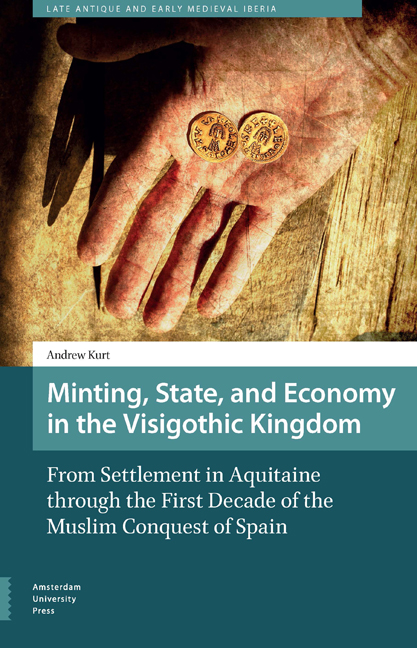 Minting, State, and Economy in the Visigothic Kingdom
Minting, State, and Economy in the Visigothic Kingdom Book contents
- Frontmatter
- Contents
- List of figures
- Acknowledgments
- Introduction
- 1 Pre-Regal Visigothic Coinage
- 2 The King’s Coinage: The Beginning and Development of theRegal Coinage (c. 573-c. 720) 81 A The Transition to a Regal
- 3 The Activities of the Mints from c. 573- c. 720
- 4 Why Were Gold Coins Struck in the Visigothic Kingdom?
- 5 The Royal Control of Visigothic Minting
- 6 Coinage in Spain in the Aftermath of the Islamic Conquest
- 7 Visigothic Currency in the Early Medieval Economy
- Conclusion
- Appendix I
- Appendix II
- Bibliography
- About the Author
- Index
3 - The Activities of the Mints from c. 573- c. 720
Published online by Cambridge University Press: 21 November 2020
- Frontmatter
- Contents
- List of figures
- Acknowledgments
- Introduction
- 1 Pre-Regal Visigothic Coinage
- 2 The King’s Coinage: The Beginning and Development of theRegal Coinage (c. 573-c. 720) 81 A The Transition to a Regal
- 3 The Activities of the Mints from c. 573- c. 720
- 4 Why Were Gold Coins Struck in the Visigothic Kingdom?
- 5 The Royal Control of Visigothic Minting
- 6 Coinage in Spain in the Aftermath of the Islamic Conquest
- 7 Visigothic Currency in the Early Medieval Economy
- Conclusion
- Appendix I
- Appendix II
- Bibliography
- About the Author
- Index
Summary
Abstract
Chapter Three surveys the material aspects of coin production and explains how the minting of gold in the regal period was organized. Close to one hundred Visigothic mints are now known, although the actual site is not identified in all cases. Knowledge of the mints’ organization cannot rely directly on contemporary documentation, but rather on coin types and painstaking study of styles. The chapter argues that die engravers (and their teams) were often not attached to a single mint but instead traveled across large territories for coin production at several sites. Although minting frequently followed a loose provincial or regional organization, engravers crossed into neighboring provinces. An analysis of the coins’ metallic quality and its vicissitudes rounds out the chapter.
Keywords: mints; gold; types; style; weight; fineness
The Operation of the Mints
For information on the techniques of coin production and the personnel involved at all levels in late Roman and early Byzantine minting, one can draw on written, epigraphical, and pictorial sources. By contrast, only a small amount of written material is left to inform us of those responsible for minting in the Visigothic kingdom, and nothing remains about their methods of work. For the latter, one is forced to rely on the coins manufactured at Visigothic mints, as well as on other contemporary currency that they resemble.
Material Aspects
As the successor states of the Roman West developed their own coinages in the fifth and sixth centuries, the currency kept most of the physical features of imperial coinage on which it was based. Some of the barbarian kingdoms minted coins in three metals, as Byzantium continued to do. As we have already seen, in Gothic Spain from the late sixth century onward the tremissis was the main coin and was the only gold denomination. In weight standard (1.516 grams), it conformed to the original model of the Byzantine tremissis, though the diameter of imperial issues had undergone changes by the time of Leovigild and the size of Visigothic tremisses had become much larger (usually 18-20 mm). The similar appearance of Visigothic and Byzantine tremisses, aside from their use of the same types for many years, is due to similar techniques of production.
- Type
- Chapter
- Information
- Minting, State, and Economy in the Visigothic KingdomFrom Settlement in Aquitaine through the First Decade of the Muslim Conquest of Spain, pp. 123 - 172Publisher: Amsterdam University PressPrint publication year: 2020


